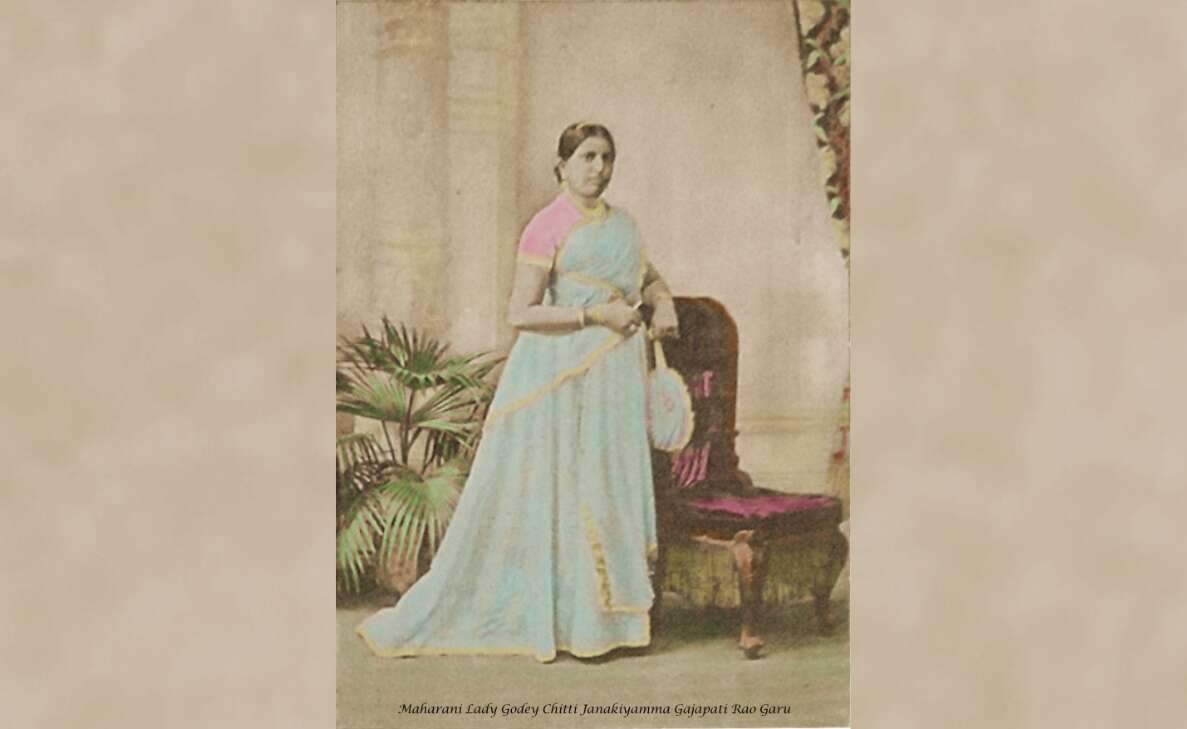

The Goday family, which once ruled Visakhapatnam as the Maharanis and Maharajahs, have benevolently contributed chunks of their wealth to developing it. From donating lands for the construction of hospitals, schools, and colleges, to overseeing their seamless functioning, the royal family have left an indelible impression on the city with their kindness. John Castellas, a Vizag heritage enthusiast and aficionado, narrates the story of Lady Chitti Janakiyamma, the last Maharani of Vizagapatam.
Formally, she was Maharani Lady Chitty Janakiyamma Goday Narayan Gajapathi Rao, the third wife of the last Maharajah of Vizag. She was the adoptive daughter of his sister and her husband. She was also the stepmother to Maharajah’s two daughters- the Ranis of Wadhwan and Kurupam.
The Maharani, as a young girl, was adopted into the family of the Maharajas’ sister, Ratnayamma and her husband, GL Narsingha Rao. She was educated by an English Governess and was fluent in English, Telugu and Sanskrit. Following her marriage to the widower Rajah, she moved to Madras where she lived in purdah. As the wife of the Rajah as a Member of the Legislative Council, she mixed with the wives of the English and Indian high society in Madras. There are reports of her hosting receptions for the Governor’s wife and also Purdah parties for the marriages of the Rajah’s two daughters to the Thakor Saheb of Wadhwan and the Zamindar of Kurupam respectively.
Maharanipeta in Vizag is the enduring legacy of the lady as, in 1903, she funded the clearing of the prickly pear weeds and building of the road from Daba Gardens to the sea which was a significant phase in the urban spread of the old town of Vizagapatam. Following the death of the Maharajah, she resided at The Mahal in old Vizag and took a leading role in continuing his many philanthropic projects. These dealings were through her Dewan, Bahadur B Narayanamurthi Pantulu, who represented her in meetings with the Collector and government officials and all public functions.
In 1904, the Maharani funded the replacement of a poor house near the Civil Hospital (the original was demolished to enable the construction of the hospital). The poor house was in accord with her late husband’s family tradition of feeding the poor in Vizag and giving shelter to the poor who attended the hospital.
In 1906, the Maharani donated to the Brahma Samaj Poor Schools and believed that according to the Shastras, education and learning were the highest form of wealth, and giving of the same was the best kind of charity. She was a generous donor to St Josephs’s Convent, LMS High School, and Hope Hall Girls School, CMS Zenana Society schools in Vizag. Maharani Lady Gajapathi Rao was the principal donor for the rebuilding of St Aloysius High School in Vizag, which had been severely battered by successive cyclones. The Maharani opened the new school building on 13 May 1908 by her proxy (as she lived in purdah) and the Catholic Bishop Rt Rev Clerc.
The Maharani died in Vizag on 26 July 1912. The will of the late Maharajah had allowed her to adopt a male child of his daughter Rani of Kurupam to continue the Goday lineage and this she never did. She did, however, generously grant all her inherited estates to his grandchildren, the three children of the Rani of Kurupam.
This article is the second in a series of four articles about the Last Maharajah of Vizagapatam, the Maharani and two daughters, the Rani of Wadhwan and Rani of Kurupam. The portraits are painted oil on canvas by Vizag artist Sharmla Karri from photographs in European archives. As the ladies lived in purdah after marriage, their images are from photographs taken before marriage.
Should you have an anecdote or history on Vizag, the author would appreciate you contacting him at jcastell@ozemail.com.au
Written by John Castellas whose family belonged to Vizag for 5 generations. Educated at St Aloysius, migrated to Melbourne, Australia in 1966, former General Manager of Engineering at Boeing & Qantas Airways, in retirement Lecturers in Aviation Management at Swinburne University and is a Vizag aficionado.
Stay tuned to Yo! Vizag website and Instagram for more heritage stories.
The weekend is finally here, which means it is time for entertainment! No matter what…
Once upon a time, kids spent their free time chasing each other outside, climbing trees,…
If Vizag is called the city of destiny, then it means the people living in…
After a week-long wait, which felt like an eternity, the IPL is finally ready to…
Everybody loves to visit the zoo, right? It is a common place for a school…
Everyone loves a breath of fresh air, especially when it carries the comforting aroma of…
Leave a Comment